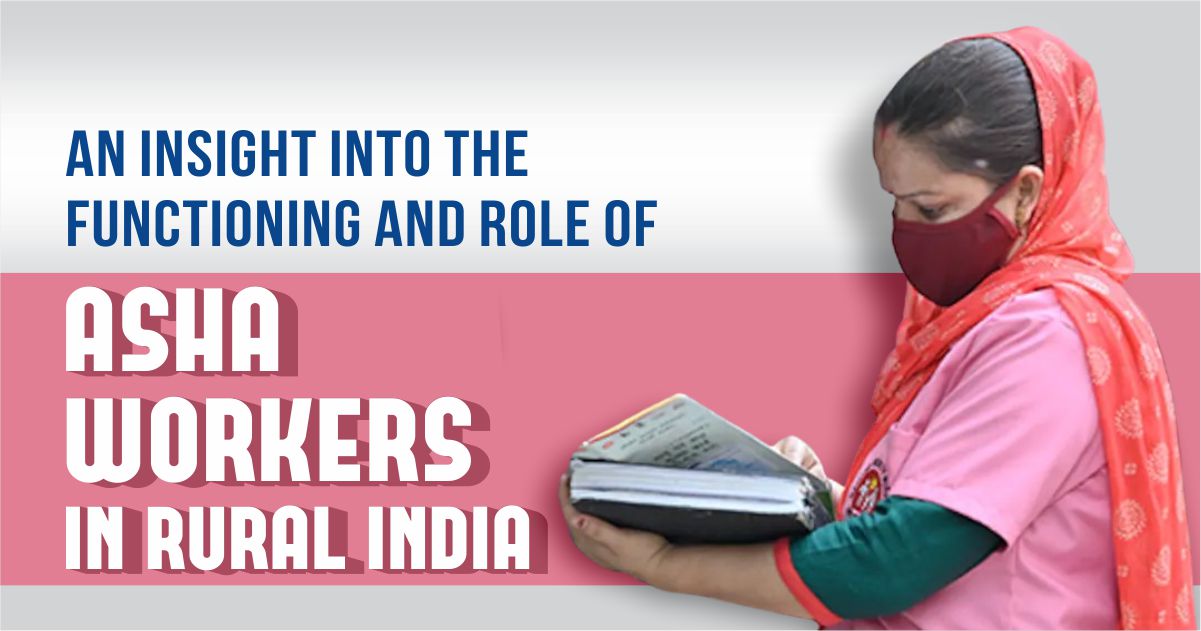A trained female community health worker is an Accredited Social Health Activist (ASHA). The ASHA, chosen from the community and held accountable to it, are taught to serve as a link between the community and the public health system.
There are currently around 9 lakh ASHAs. The ASHA program is active in 33 states (except Goa, Chandigarh & Puducherry). The role of an ASHA is that of a community-level care provider entailing a variety of responsibilities, including –
- facilitating access to health care services
- raising awareness about health care entitlements, particularly among the poor and marginalized
- promoting healthy behaviors, and mobilizing for collective action for better health outcomes
- meeting curative care needs as appropriate to the organization of service delivery in that area and compatible with her training and experience.
To understand the current scenario, functions and role of ASHA workers, we provide an insight into the potential, problems, awareness, benefits, marketing, and functioning of the ASHA workers present in the states of India. The survey enlists a sample size of 100 ASHA workers.
METHODOLOGY
We conducted a primary survey to connect the ASHA workers for the responses for an effective collection of data. The research and results have been portrayed using MS Excel and SPSS. The same has been interpreted and depicted using figures.
EDUCATION QUALIFICATION
From the figure shown above, one can derive that most of the ASHA workers in the sample taken had 10th and 12th class education, with a few graduates. This was followed by volunteers coming from 6th and 7th pass-outs. They have a primary education that helps them understand the information associated with any product and service.
WORK EXPERIENCE
The figure above indicates that most workers came with 5 to 10 years of experience. This was followed by people with work experience of 10 to 15 years. The least number of people came with 0 to 5 years of experience.
WORKING HOURS

From the figure shown above, one can observe that maximum workers worked 7 to 8 hours a day while the minimal number of people worked 5 to 6 hours per day. Depending on the distance and population, sometimes the working hours depend accordingly.
WHAT ARE THE MAJOR DUTIES AND ROLE OF ASHA WORKERS
The figure shown above shows that the maximum number of asha karykarta are engaged in the vaccination drive for COVID – 19. This was followed by equal proportions of workers working towards Covid patients, general problems, and maternity-related issues. They get responsibilities every month; due to the pandemic, the main focus is on COVID-related health facilities for all the ASHA workers.
COMMUNICATION AND INTERACTION WITH VILLAGERS
The figure shown above shows that maximum communication is achieved by going from door to door. This was followed by calling meetings in the common village area for discussion and arranging camps.
USE OF SMARTPHONES
From the figure shown above, it is observed that 58% of the participants use smartphones in their daily life. They get smartphones from the government). The remaining 42 % of workers do not have access to smartphones or do not know their usage.
Of the 52 % of workers using smartphones, 41.4 % use those for personal use, as indicated in the previous question. In contrast, the remaining people use them both personally and professionally. There are formal and informal channels between the workers to discuss their daily work and new schemes.
TYPES OF APPLICATIONS IN USE
Most smartphone users prefer WhatsApp, which is evident from the above pie chart, while the rest prefer Facebook and YouTube.
VILLAGERS’ DEPENDENCE AND TRUST
From the figure shown above, it is safe to say that a vast proportion of the population trusts the ASHA workers to solve health-related issues. The rest of the people who have started traveling to nearby towns depend upon health care workers and hospital staff for their health and family welfare issues.
APPRECIATION FOR YOUR EFFORTS
This fig shows that 80 % of the ASHA workers receive accolades and appreciation for their work. In contrast, the rest feel they are not appreciated for their contribution, although no one badmouths them.
MONTHLY INCOME
The highest proportion of ASHA workers receives 2500 – 3000 whereas the workers receiving 3000 to 3500 per month is relatively low. The compensation also varies according to demographic factors such as population or any ongoing vaccination or health drives. A minimum amount of Rs 2000 is fixed for Asha workers irrespective of other factors.
ENGAGEMENT WITH DIFFERENT ORGANISATION
A significant proportion of the workers are not connected to or are part of any community resource person of any company. In contrast, a low percentage are part of or are related to any company. One of the reasons is the public health centers provide free health and pharma products; having a short bundle of budget; they have to spend judiciously.
Companies operate in sanitary napkins, contraceptive pills, condoms, and health and nutrition supplements. They generally get opportunities to promote local brands’ products, which are affordable in rural areas. They also get opportunities to work for survey-related work for different NGOs and research projects by public and private entities.
The incentives and benefits are different based on the work and time. Some organizations provide monetary incentives; for others, they work willingly with no benefits associated.
JOB SATISFACTION
This figure shows that around 74 % of the ASHA workers love the work they are doing, whereas the remaining 26 % say that they have no other option than work as an ASHA worker. Indicating that most workers feel that they are working for a good cause, whereas on the other hand, some people work as part of ASHA because they don’t have any other opportunities available to them.
CONCLUSION
ASHA workers play an essential role in the health sector of rural India, wherein they keep in check the villagers’ health problems and provide help and solutions in this regard. Government helps these ASHA workers by providing different incentives to compensate for the noble work since the salary is less as the work is voluntary based work. From the survey, it was evident that people trust and depend on ASHA workers for health and family welfare related issues. Also, they can play a major role in rural marketing in India.


















One Response
Very good write-up. I absolutely appreciate this site. Thanks!